by Mike Gulett –
It is always a thrill when I see a classic car on the street being driven around. We all saw cool, classic cars on the streets in our youth but we did not know they would someday be rare classics because they were just ordinary drivers back then.
Here are my photos of Cars on the Streets from Monterey Car Week this year. I did not get as many photos as I usually do because I was driving and was not able to take a photo of every car that I wanted to.
Many cool classic cars are only seen at a car show, which almost always takes place on a golf course or a park where the cars sit on a grass field instead of a street. The grass is easier on our feet and it is cooler than asphalt on a sunny day. However, it is not as realistic as a street.
Drivers with their cars on the street create their own car show during Monterey Car Week especially in downtown Carmel-by-the-Sea.
Some of these cars may have been at a show, they may be on their way to a show but they did not drive by in a trailer – they were all driven under their own power on that day in that place.
Let’s drive our cars and grieve not.
Though nothing can bring back the hour
Of splendor in the grass, glory in the flower
We will grieve not; rather find
Strength in what remains behindWilliam Wordsworth
Let us know what you think in the Comments.
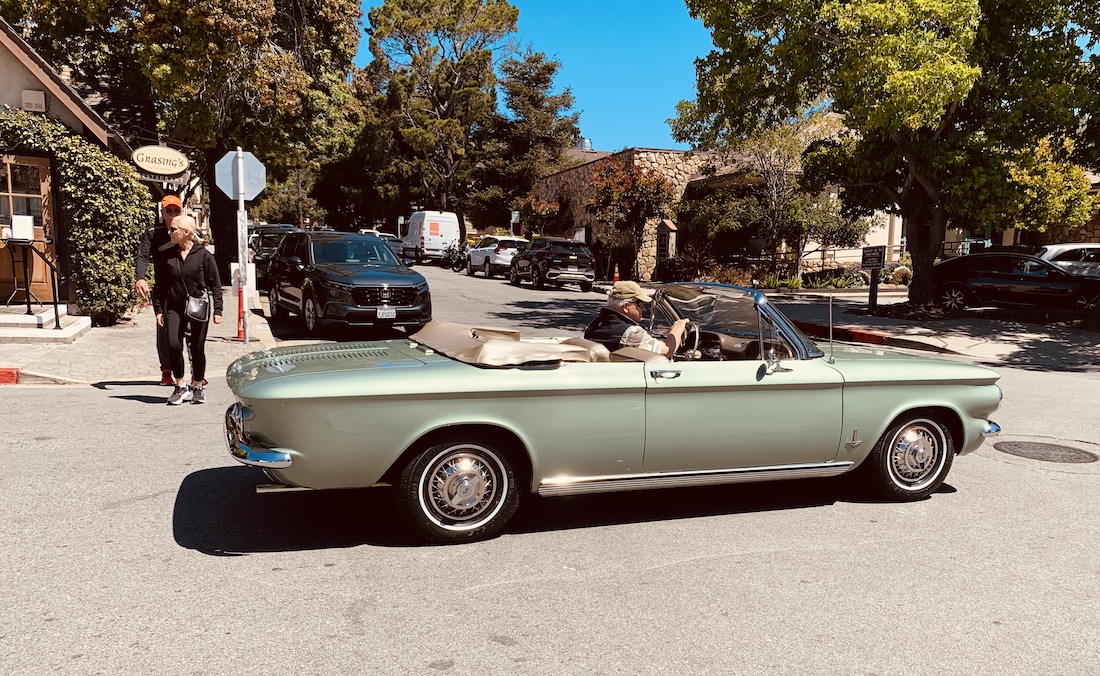
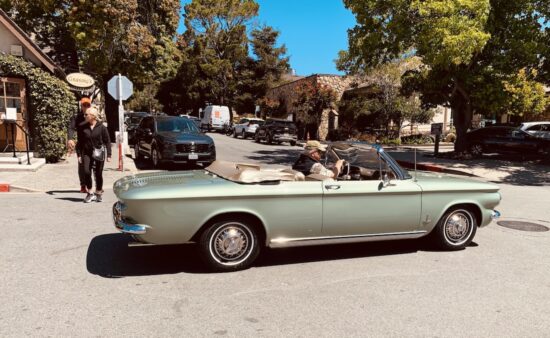
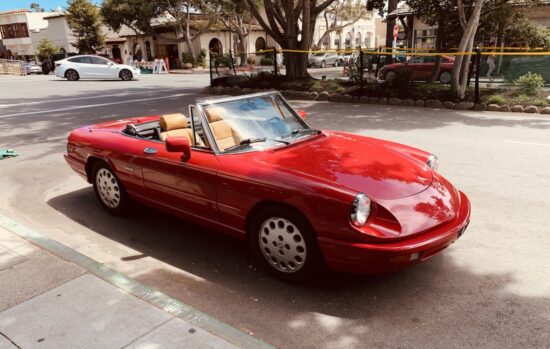
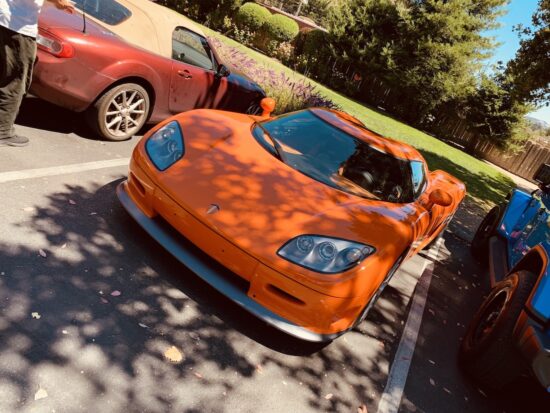
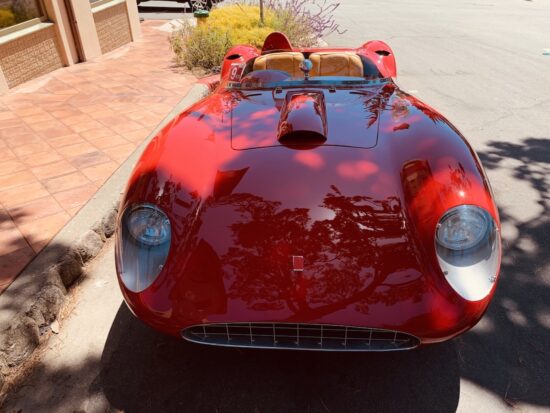
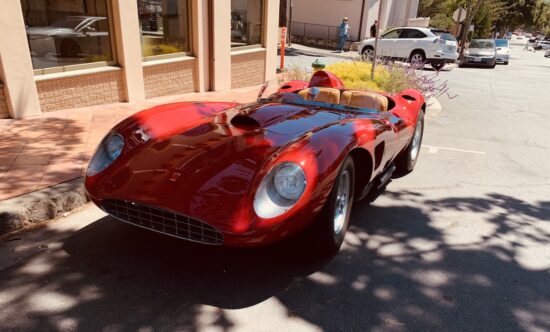
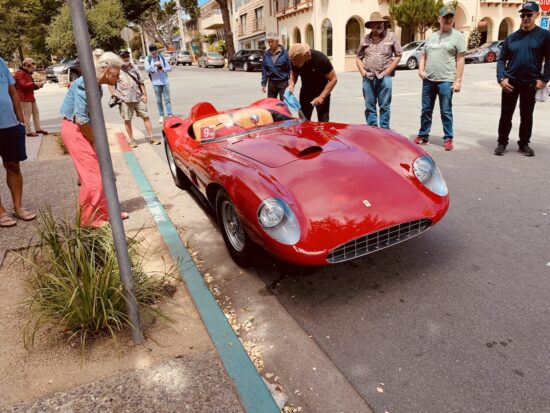
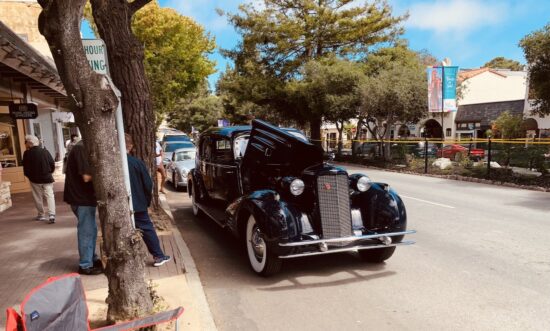
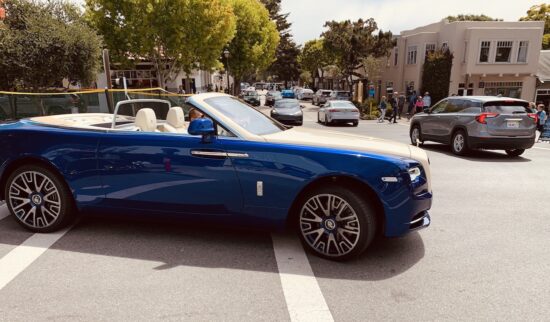
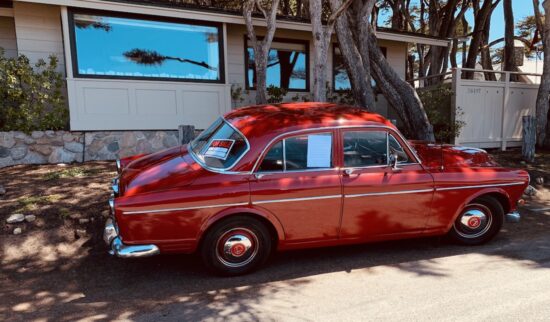
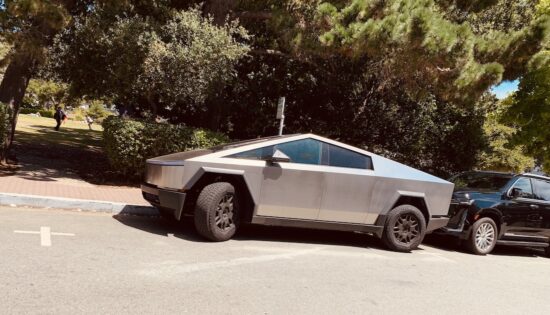
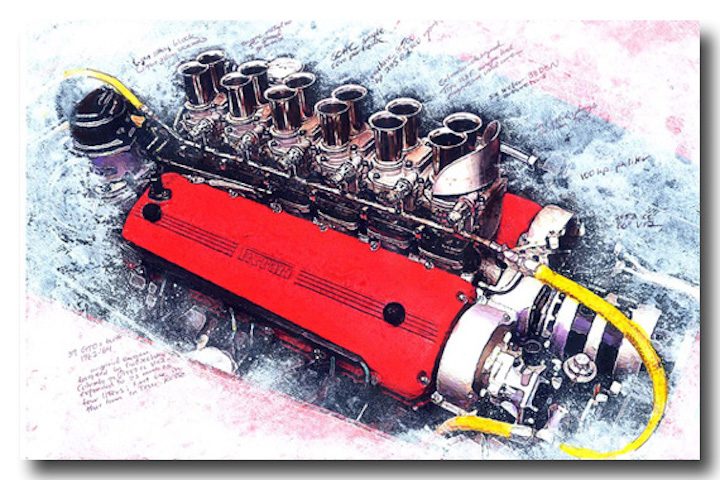

This seems like a good time to ask about this car. I am completely baffled about what it is. The back end has cues of Corvette. so I think GM. I was stuck in a left turn lane or I would have followed him. Photo is through the windshield so a lot of glare. Other than the wheels, I think it’s great.
Buick Riviera I think.
Right you are. More precisely a Buick Riviera Boattail. My wife said it was a Buick, but an image search without the “boattail” failed to find it.
Wes, you’re absolutely correct! More precisely, it’s a 1972 – 1974 model. Buick actually brought the beautiful “boat tail” design to production – And then, they scared themselves! For 1975 they “dumbed down” the creative elements and revised the car to a conventional back window, roof and trunk. In conjunction with the added ugly 5MPH bumpers, the overall uniqueness of the Riviera’ s design was sacrificed for landau vinyl roofs, fake wire wheel covers, velour upholstery, and oversized chrome grilles w/ stand-up hood ornaments – changing Riviera’s marketing direction to appeal to conservative (older) buyers. To see one in person today is a fabulous treat!
I must be getting old as the original Riviera was a milestone vehicle upon its release. This boat tail version came along as an update to the original. The companion GM vehicles where the Cadillac Eldorado and Oldsmobile Toronado , both being front wheel drive compared to the Riviera which was rear drive.
I know I’m getting older. GM also build a motorhome on the Toronado platform. Quite advanced for the time.
Here are some details of the “Boattail” Riv’:
Third generation (1971–1973)
Overview
Model years 1971–1973
Assembly Flint, Michigan, United States (Buick City)
Designer Jerry Hirshberg under Bill Mitchell
Body and chassis
Body style 2-door hardtop
Layout FR layout
Platform E-body
Related Cadillac Eldorado
Oldsmobile Toronado
Powertrain
Engine 455 cu in (7.5 L) Buick V8
Transmission 3-speed TH-400 automatic
Dimensions
Wheelbase 122.0 in (3,099 mm)[27]
Length 217.4 in (5,522 mm) (1971)
218.3 in (5,545 mm) (1972)
223.4 in (5,674 mm) (1973)
Width 79.9 in (2,029 mm)
Height 54.0 in (1,372 mm)
Curb weight 4,247 lb (1,926 kg)
The Riviera was radically redesigned for the 1971 model year with flowing and dramatic “boat-tail” styling. Designed under Bill Mitchell’s direction, it was penned by Jerry Hirshberg, future head of design for Nissan, mating the two-piece vee-butted fastback rear window, inspired by the 1963 Corvette Sting Ray coupe, to the Riviera’s platform.
The design was originally intended for the smaller A-body or its related G-body, as shown by a full scale clay model of an A-body based boat-tail Riviera recently revealed.[30] Given the late stage of the 1968-72 A/G platform evolution and accretive cost to add another version to it, GM Management decreed that the next Riviera use the full sized GM B platform body—expanded for 1971 by 3 in (76 mm) in wheelbase and more than 120 lb (54 kg) heavier— which produced controversial looks, making for a sharp departure from those of the Toronado and Eldorado. (Collectible Automobile ran an article about 1971–76 full-sized Buicks in which one sketch design for their 2-door coupes which was rejected resembled the 1971–73 Riviera).
This generation introduced a much more visual representation of the “sweepspear”, with a more faithful representation to the version that appeared on 1950s Buicks in both the side molding and beltline.[31] Large, round wheel openings were intended to convey more of a sporty air.[31][clarification needed] The only engine available was Buick’s own 455 ci V8 engine producing 315 hp (235 kW), with 330 hp (246 kW) with the Gran Sport (GS) package.[32]
The 455 engine had a lower compression ratio to meet EPA emissions requirements, together with the shift from SAE gross to SAE net ratings this reduced claimed power to 255 hp (190 kW), with 265 hp (198 kW) in the Gran Sport. Performance remained reasonably brisk, with a 0–60 mph time of 8.1 seconds for the GS, but the Riviera’s sporty image was rapidly fading.[according to whom?] One noteworthy advance was Buick’s Max Trac traction control.[33] The 1971 Riviera also features GM’s “Full-Flo” ventilation system and two large deck lid louvers are prominent on the trunk lid.
Despite these features, Riviera sales for 1971 dropped to 33,810,[34] the lowest to date. The 1972 Riviera received a new, egg-crate grille, more substantial front bumpers to prepare for the new 5-mph impact legislation, restyled taillight trim, and the louvers were removed from the trunk lid. The 1972 Riviera also featured a redesigned ventilation system, and the 455 engine switched to net power ratings, 225 hp (168 kW) or 250 hp (186 kW) in the Gran Sport, although the actual drop in net power was only 5 hp (4 kW). Sales remained stagnant at 33,728, a drop of 82 from the prior year.[35]
For 1973, the Riviera underwent a number of changes.[36] The front bumper was redesigned to be thicker and featured bumper guards as standard in order to meet 1974 impact-bumper standards, the grille was switched back to horizontal slats, and the front lamps were moved from the bumper and were now integrated into the headlights, wrapping around the corners of the car. Sluggish sales of the third generation Riviera led GM to believe that the boattail deck lid was too radical for most customers’ tastes, so in 1973 it was blunted and made slightly shorter. The taillights, meanwhile, were moved down from the sheet metal and into the bumper, and the rear license plate location was moved from the left side of the bumper to the center.[36] The 250 hp (186 kW) engine became standard, with 260 hp (194 kW) with the Stage One package. This also included a limited-slip differential and a chrome-plated air cleaner. The “Gran Sport” package was still available as a separate option package consisting of a ride-and-handling package that included a rear stabilizer bar, JR78-15 whitewall steel-belted radial tires, a specially tuned “radial roadability” suspension, additional sound insulation and special “Gran Sport” badging. The design changes however only led to a marginal increase in sales, with 34,080 being produced for the model year.
Glenn in Brooklyn, NY
Third generation (1971–1973)
Third generation
1972 Buick Riviera
Overview
Model years 1971–1973
Assembly Flint, Michigan, United States (Buick City)
Designer Jerry Hirshberg under Bill Mitchell
Body and chassis
Body style 2-door hardtop
Layout FR layout
Platform E-body
Related Cadillac Eldorado
Oldsmobile Toronado
Powertrain
Engine 455 cu in (7.5 L) Buick V8
Transmission 3-speed TH-400 automatic
Dimensions
Wheelbase 122.0 in (3,099 mm)[27]
Length 217.4 in (5,522 mm) (1971)
218.3 in (5,545 mm) (1972)
223.4 in (5,674 mm) (1973)
Width 79.9 in (2,029 mm)
Height 54.0 in (1,372 mm)
Curb weight 4,247 lb (1,926 kg)
The Riviera was radically redesigned for the 1971 model year with flowing and dramatic “boat-tail” styling.[28] Designed under Bill Mitchell’s direction, it was penned by Jerry Hirshberg, future head of design for Nissan, mating the two-piece vee-butted[29] fastback rear window, inspired by the 1963 Corvette Sting Ray coupe, to the Riviera’s platform.
The design was originally intended for the smaller A-body or its related G-body, as shown by a full scale clay model of an A-body based boat-tail Riviera recently revealed.[30] Given the late stage of the 1968-72 A/G platform evolution and accretive cost to add another version to it, GM Management decreed that the next Riviera use the full sized GM B platform body—expanded for 1971 by 3 in (76 mm) in wheelbase and more than 120 lb (54 kg) heavier— which produced controversial looks, making for a sharp departure from those of the Toronado and Eldorado. (Collectible Automobile ran an article about 1971–76 full-sized Buicks in which one sketch design for their 2-door coupes which was rejected resembled the 1971–73 Riviera).
This generation introduced a much more visual representation of the “sweepspear”, with a more faithful representation to the version that appeared on 1950s Buicks in both the side molding and beltline.[31] Large, round wheel openings were intended to convey more of a sporty air.[31][clarification needed] The only engine available was Buick’s own 455 ci V8 engine producing 315 hp (235 kW), with 330 hp (246 kW) with the Gran Sport (GS) package.[32]
The 455 engine had a lower compression ratio to meet EPA emissions requirements, together with the shift from SAE gross to SAE net ratings this reduced claimed power to 255 hp (190 kW), with 265 hp (198 kW) in the Gran Sport. Performance remained reasonably brisk, with a 0–60 mph time of 8.1 seconds for the GS, but the Riviera’s sporty image was rapidly fading.[according to whom?] One noteworthy advance was Buick’s Max Trac traction control.[33] The 1971 Riviera also features GM’s “Full-Flo” ventilation system and two large deck lid louvers are prominent on the trunk lid.
Despite these features, Riviera sales for 1971 dropped to 33,810,[34] the lowest to date. The 1972 Riviera received a new, egg-crate grille, more substantial front bumpers to prepare for the new 5-mph impact legislation, restyled taillight trim, and the louvers were removed from the trunk lid. The 1972 Riviera also featured a redesigned ventilation system, and the 455 engine switched to net power ratings, 225 hp (168 kW) or 250 hp (186 kW) in the Gran Sport, although the actual drop in net power was only 5 hp (4 kW). Sales remained stagnant at 33,728, a drop of 82 from the prior year.[35]
For 1973, the Riviera underwent a number of changes.[36] The front bumper was redesigned to be thicker and featured bumper guards as standard in order to meet 1974 impact-bumper standards, the grille was switched back to horizontal slats, and the front lamps were moved from the bumper and were now integrated into the headlights, wrapping around the corners of the car. Sluggish sales of the third generation Riviera led GM to believe that the boattail deck lid was too radical for most customers’ tastes, so in 1973 it was blunted and made slightly shorter. The taillights, meanwhile, were moved down from the sheet metal and into the bumper, and the rear license plate location was moved from the left side of the bumper to the center.[36] The 250 hp (186 kW) engine became standard, with 260 hp (194 kW) with the Stage One package. This also included a limited-slip differential and a chrome-plated air cleaner. The “Gran Sport” package was still available as a separate option package consisting of a ride-and-handling package that included a rear stabilizer bar, JR78-15 whitewall steel-belted radial tires, a specially tuned “radial roadability” suspension, additional sound insulation and special “Gran Sport” badging. The design changes however only led to a marginal increase in sales, with 34,080 being produced for the model year.